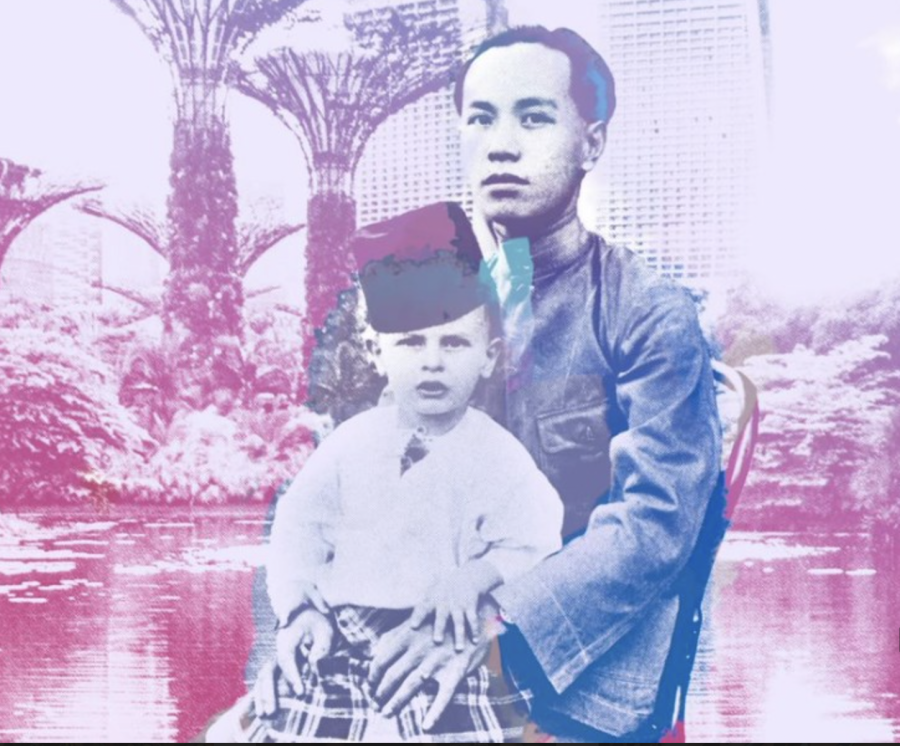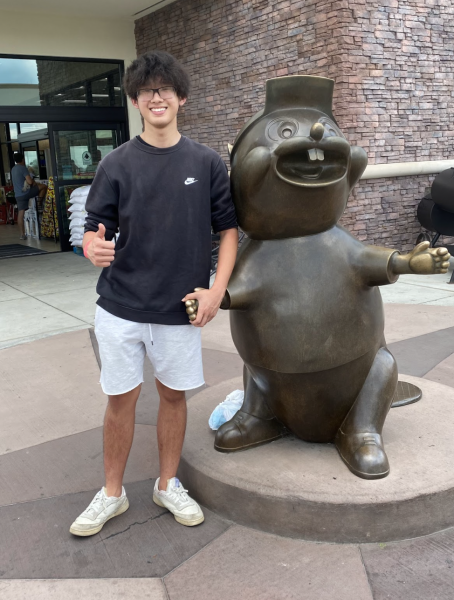Travel to Asia with these AAPI month area attractions
A part of Tristan Cai’s exhibit, this photograph depicts a ‘houseboy’ with a European boy sitting on his lap. The usage of halftone color separation and intricately arranged solid colored dots allow for new details and ghosting effects to emerge at different viewing distances.
May 15, 2023
In 1841, 14-year-old Nakahama Manjirō was forced to become the man of his family after his father passed away. To support his family, he found work as a fisherman and joined a crew of brothers to catch bonito fish. However, their voyage was disrupted when a ferocious storm swept their boat, shipwrecking them off the coast of Torishima Island. There, they spent months trying to survive before William H. Whitfield, captain of the American whaleship the John Howland, rescued them. Due to Japan’s closed-door policy, the brothers were left behind in Honolulu, but Whitfield adopted Manjirō, making him the first official Asian immigrant to the U.S.
Since then, Asian Americans and Pacific Islanders (AAPIs) have faced multiple challenges in America, whether it be the colonization of Hawaii, the Chinese Exclusion Act of 1882, Executive Order 9066 and more. However, numerous strides from local activists and national organizations have allowed the AAPI diaspora to recognize, reflect and celebrate their history and heritage. Here are some events around the DMV area that truly capture the AAPI spirit.
The Aesthetics of Disappearance Exhibit (May 1-20 @ 11:00 AM)
Located in the Asian Arts Gallery at Towson University, “The Aesthetics of Disappearance” is an archival exhibit created by Tristan Cai, a Singaporean multimedia artist. In this showcase, Cai seeks to explore the censorship of history, especially as it relates to the trafficking of Asian slaves (also known as ‘Houseboys’) throughout the British colonies of Hong Kong, Singapore and Darwin. His usage of halftone color separation and visual illusions, combined with photographs of houseboys in various European colonies, creates a particularly powerful meditation on how easily stories of oppression and marginalization can be erased from the collective consciousness.
DC South Asian Literary Festival (May 6-7 @ 12:30 PM)
Hosted by the Writers’ Center in Bethesda, the DC South Asian Literary Festival invites South Asian authors, poets, screenwriters and translators to discuss their works and offer their insights into the ongoing discussions of Asian representation in the publishing and literary scenes. Attendees have the opportunity to interact with a plethora of influential artists and academics, from journalist Seema Sihori and psychiatrist Dr. Ali Hashmi to poet Arundhati Subramaniam and author Naheed Patel.
Kahini Books will also have a pop-up bookstore at the literary festival, featuring used and new books from established and emerging South Asian writers. Priced around an affordable 15 dollars, Kahini Books provides readers a chance to explore the often-forgotten stories and experiences that permeate South Asian fiction.
Kamayan Feast (May 12 @ 6:00 PM)
In Tagalog, the word Kamayan directly translates to “eating with the hands.” The Kamayan Feast, also known as salu-salo, is an integral part of Filipino culture, where rice and dishes are placed upon banana leaves and eaten with hands. Usually experienced during special events or fiestas, its communal and intimate atmosphere is often associated with the pre-colonial Philippines.
The Motor House in Baltimore will be organizing a Kamayan Feast for everybody to enjoy on May 12. With delicious Filipino dishes—including pritong isda, lechon baboy, atsaa, and more—traditionally laid atop banana leaves on a long banquet table, it is sure to be a joyful time for lively conversation and community fellowship.
The Art of Lei Making (May 15 @ 5:00 PM)
Throughout the Pacific Islands (specifically, Hawaii and Polynesia), leis are symbolic and beautiful garlands that are often composed of natural foliage, such as feathers, seashells and tropical flowers like plumerias and pikakes. Historically worn as a marker of royalty and religion, lei-gifting acts as a sentimental and respectful way to show one’s affection and friendship towards somebody else.
On May 1, Native Hawaiians honor the tradition of lei making—and more broadly, Hawaiian culture—by celebrating Lei Day. In the Kentlands Mansion of Gaithersburg, Kumu Kaimana Chee will lead a Native Hawaiian cultural workshop, where he will teach the process of crafting a lei and participate in a traditional Hawaiian chant and hula performance.
Tai Chi & Tea (May 20 @ 1:00 PM)
During the 15th century, Japanese tea connoisseur Murata Jukō coined the idiom 禅茶一味: “zen and tea are of one taste.” In East Asian cultures, the practices of Tai chi and tea ceremonies both center around the philosophy of Zen Buddhism, where meditation and self-realization are vital in reaching an enlightened and transcendental state of being.
For Tai chi, a Chinese martial art, its emphasis on internal power and wu wei (effortless action) is reflected in how martial artists aim to yield and redirect an attack instead of fighting back. Likewise, in traditional Japanese tea ceremonies, the ritual of finding quality tea leaves, whisking together matcha and water and serving the finished drink to guests is reminiscent of the traditional wabi-sabi worldview. Synergy and Serenity, a wellness center based in Dupont Circle, will synchronize these complementary practices to provide a calming and relaxing introductory class to the arts of Tai chi and tea making.
Regardless of the event that one chooses to participate in, it will undoubtedly reaffirm the rich and diverse cultures and histories of Asian Americans and Pacific Islanders.



